How To Fix Old Windows With Ropes
Or maybe it's re-rope sash, or restring windows, or re-weight with sash cord? No matter, sit back, buckle in, and get ready for a riveting blog post about restoring antiquarian windows! I doesn't get much more than exciting. (I'm lying, information technology can only get more than heady.)
Antique double hung windows are beautiful, there's no dubiousness about information technology. I didn't realize this for many years, but later buying our habitation and falling in love with quondam homes, the old sash are one of the four truly enchanting elements of architecture I feel set an older dwelling house apart from the pack (the other three are their staircases, period doors & door hardware, and moulding/millwork). When I'm drooling over a mag house, a existent estate listing that I can't afford, or a falling down business firm with "good bones" I just wish I could spend some other decade saving, these are some of the primary aspects I immediately look for. And if any of these homes are lacking any or all of these details...they're dead to me.
While I'chiliad an equal opportunity lover of one-time windows, the majority of my restoration efforts are geared toward the style of windows in our dwelling house -- rope and caster double hung sash. This is primarily because they're the ones with which I'm most familiar and comfortable.
Our style of windows are actually very common in the era of our 1880s dwelling, and in nigh fifty years in either direction. The mode is adequately straight frontward and contains ii sash, an upper and lower, which are movable and counter balanced by big weights that live in cavities beyond the jambs of the window frame. When the sash are raised or lowered, the sash weights, attached to the sash by cording, travel up and down in the hollow channels, allowing the windows to stay open without any other props or stays. It'southward a very functional system that works quite well. However, i of the common plights of the rope and caster double hung sash comes by way of frayed and cleaved ropes (or sash cord).

Afterwards years of utilize and abuse, these weight cords begin to wear away. They're often painted by careless contractors, snagged by nails or hangers added in incorrect places, rotted by moisture, or merely plain pulled on by one also many people. After they've had enough, they surrender.
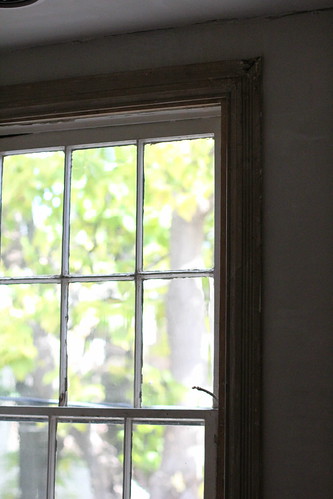
The best news near these weight cords is they're rather easily replaced, but there are a few tricks I've picked upwardly along the style that makes the process much easier.
Replacement Cord Material
The first step in replacing sash cord is to determine the material you lot'll use in the project. There are really several different options out at that place for you, from "in kind" to "long lasting." The truth is, as far as I've been led to believe, each is acceptable and information technology only comes down to preference.
Typically, you'll consider replacing your rope either with some other rope, or replacing information technology with sash concatenation.
I really take a bag of sash concatenation in our basement as I had planned on using it in the first window I needed to restore, simply I ran into a snag. No, not a snag in the project, and aesthetics snag. I saw the chains installed in another home's windows.
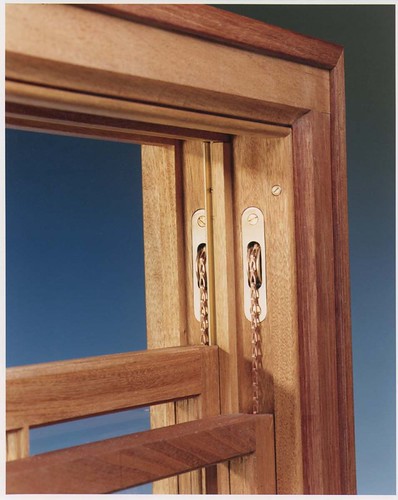
Photograph Credit: Wood Window Workshop
I don't know why, just the chains just don't do it for me. When I saw them they looked wrong for our house, and when I opened the window and heard the metal on metal clank of the concatenation rolling over the pulley, that killed it for me. I thought to myself, "I know the original cord in our windows is, well, original, so why replace it with a different material? It had already lasted well-nigh 125 years."
And so my search began for suitable sash cord to replace our broken and worn cord.
Beginning I found the standard braided laundry line you can buy at most big box home improvement stores. The cord is all white with a nylon/cotton core and is the correct size for the sash cord. I thought I had constitute the perfect replacement, so I went ahead and bought 100' of it and replaced the rope in our bedroom windows.

I was feeling expert virtually my accomplishment, but at that place was e'er this little vocalization in the back of my head proverb "that rope wasn't perfect, it didn't wait identical to the old stuff. The old stuff had lilliputian ruby-red dots in information technology."
I shut that footling voice out of my head until one day, when I was looking around online, and came beyond SRS Hardware, a company dedicated to the historic preservation and recreation of true divided light windows and wood storms. They have a cracking drove of necessities for people restoring windows, including the elusive Sarco glazing. In their listing of products they had EXACTLY what I was looking for...and I hateful exact!
They carry a type of sash cord that is fabricated by the same manufacturer of sash cord that was used on our original windows. Same small-scale company, same design, same lilliputian cerise dot. Information technology was a moment of pure, unadulterated excitement when I discovered this source.
It was also a roughly this moment when I once once again had it reinforced that I'k an admittedly huge nerd that is able to get tremendous excitement from the most mundane and lame things. Twelve twelvemonth quondam me, you grow up to be super lame.
I immediately ordered 100' to apply on all of our remaining windows (then I started fighting the internal voice about replacing it on the windows I'd already done).
Upper Sash Restring
With the sash cord in manus I started my restring process with all of the cords, weights, and sash out of the window, and the weather condition stripping in place. Just look at it, 125 year quondam compared to new!
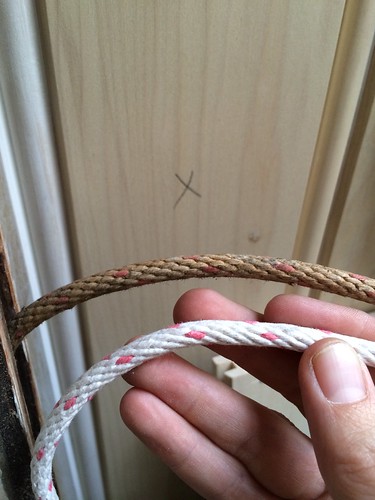
If you lot're post-obit along and doing this project on your ain, there are a few modest differences if you haven't completely torn apart your window like I did, but all of the principles still apply.
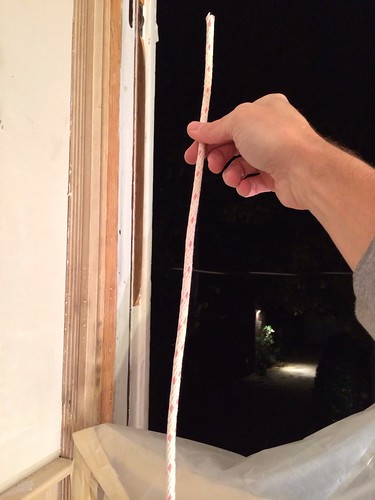
My starting time step is to feed the cord trough the pulleys. The upper sash is a footling harder than the lower due to the fact the caster must already be in place since information technology needs to be there before installing the weather condition stripping.
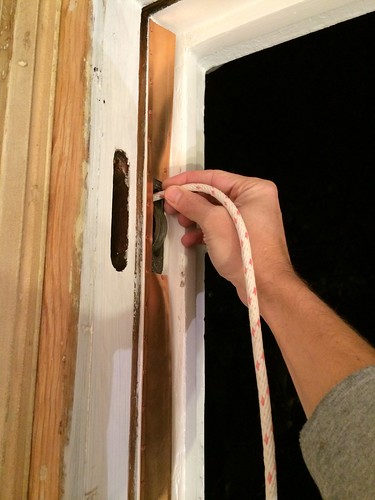
However, I only placed the upper sash pulley at this point, leaving the lower sash caster out for the fourth dimension beingness. This allows me to begin by stringing the cord through the first pulley and then grabbing it through the other pulley hole.
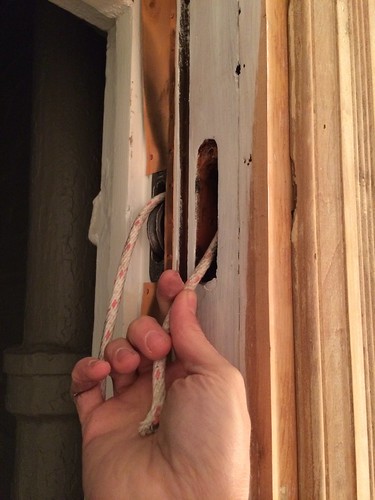
At that bespeak I tape a big drill bit to the end of the sash string and drop it down within the cavity until I can catch it through the lower opening.
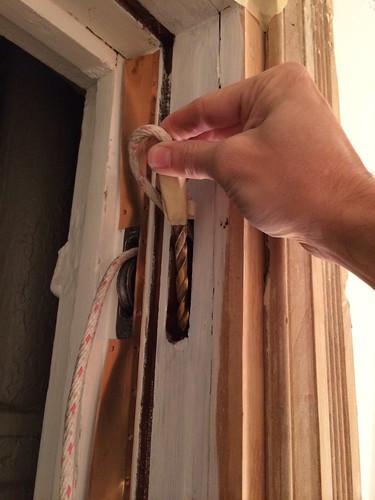
At present, I haven't mentioned length yet, and that's for expert reason. Each window has its ain unique measurements, and you'll need to determine correct length as yous go. I similar to only feed the string from the rolled up pocketbook before I e'er brand my outset cutting.
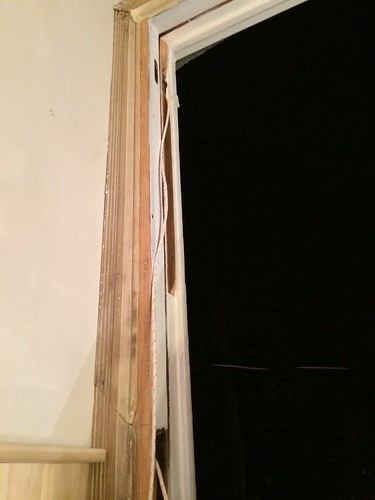
It's of import to remember that the correct part of the sash actually determines the length, and the length of the weight and where the rope attaches to the window plays a office. The rope needs to exist long enough to allow the sash to exist fully lowered without the weight or knot running into the pulley, and short plenty to allow the windows to be fully raised without having the weight hit bottom. You besides demand to account for the necessary knots you'll need to tie at either ends. This is why I similar to figure out length as I go, rather than trying to come up with a formula.
My side by side step is to necktie the new sash string to the quondam weight. I grab the weight that I labelled for the upper sash and begin preparing the knot. My goal is to tie a knot that's secure and as much like the original knot as possible. There's a reason why it lasted 125 years. Hither'south an example of the old knot...

...And here's the completed and new knot, fix for years of service.

Tying the knot is just 3 easy steps.
Step 1: Run the cord through the superlative of the weight.
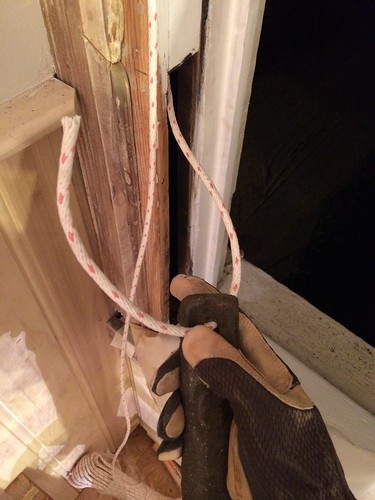
Step 2: Loop the string around the back of the in-feed piece of cord.

Step three: Loop the stop of the cord dorsum around to the forepart and through the loop, pulling the knot tight.
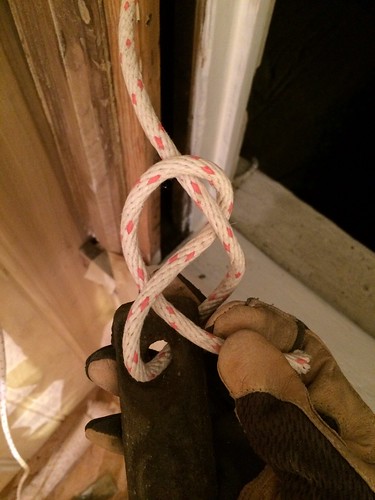
With the knot tightly tied, constrict the weight back in its pocket and move onto the side by side pace.

The next step in proper measurement is critical and will make or break your restring. With the weight back in the pocket, grab the upper sash and make pencil mark of where the top of the hole for the rope knot sits on the side of the sash.
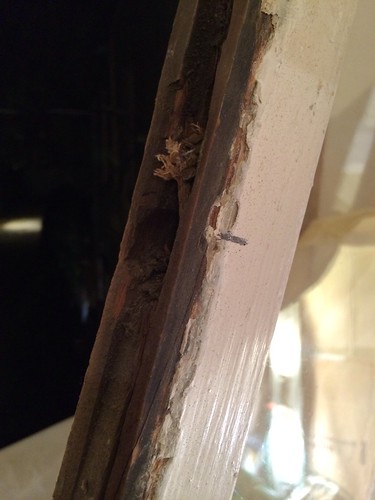
Lift the sash upward into the window in the location where it will sit when fully closed and apply a pencil to mark the jamb where the pencil mark on the sash is. This will tell you where the upper extent of the sash cord knot should sit.
Remove the sash from the window and place the sash back where you were storing it. Then grab the sash cord and pull downwards until the sash weight lifts up nearly ane inch from the bottom of the weight cavity flooring. Full tension from the weight should be on the rope and you should be able to move it freely.
With the weight i inch off the base, use your pencil to marking the rope with ii pocket-size marks. The commencement mark is at the line you fabricated on the jamb for the sash knot hole and the 2nd is at the based of the pulley, right where the rope would begin to wrap around the pulley wheel.

These ii marks are your principal points of reference for where the rope should end up once fully installed.
Now you lot can grab your scissors, as it'southward fourth dimension to cutting. To cut your rope, locate the mark for the sash knot hole then cut about one foot lower, giving yourself enough of excess.
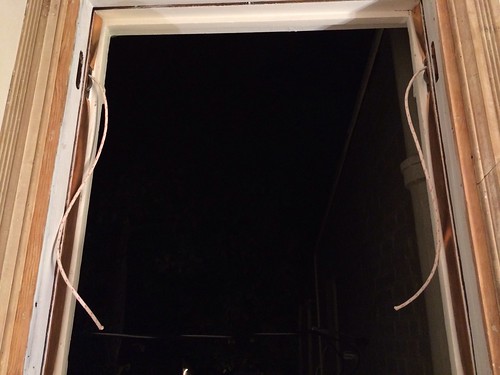
Side by side, tie a very tight knot that is pocket-sized plenty to fit in your sash knot hole, and attempt to place that knot directly on the middle of the pencil mark. I typically do a simple pretzel knot that I necktie as snug as I can. The well-nigh important thing is for the knot to be no bigger than the hole allows, i.e. information technology tin can't be spilling over or too thick. Test fit your knot, and once you're happy, cut your cord virtually an inch below the terminate of your knot.
Attaching the sash cord to the sash is not necessarily a two person job, but two people makes it a lot easier. That being said, I've done this with by myself several times, and I've merely almost fallen out of the window once.
The easiest way to do this is to accept one person concord the sash while another puts the rope in place.
The original rope installed in our windows was tacked in place by several nails through the sash's rope channel. While this was effective, I want to exist able to easily remove the sash in the time to come when I restore them.
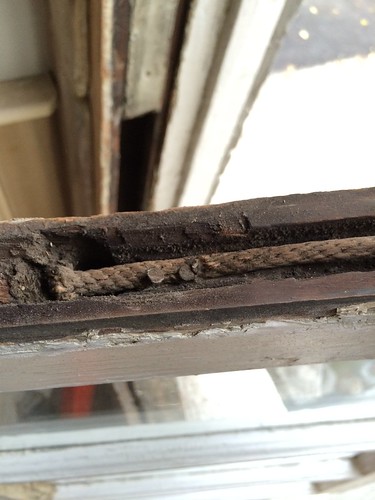
Rather than using nails once again, I opt to use a screw, as I can identify and remove it when necessary. It feels like I'm cheating a lilliputian but, only I really feel like it works quite well. At this point in just using a unproblematic 1-i/four" drywall screw since it's purely temporary.
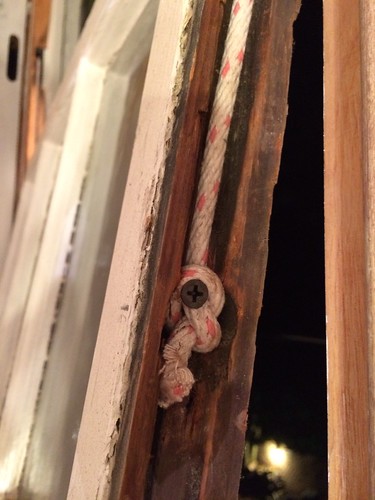
When I actually put in the sash subsequently restoration, I'll use a #8 stainless slot head spiral.
Place the spiral correct through the middle of the knot and into the sash, only don't sink the screw all of the way. But identify it deep enough to be secure.
Still property the sash, catch the other rope and place it in the aforementioned fashion, so slide the upper sash into place.

Take a pace dorsum and admire your work. You lot've just restrung half of your window!
Lower Sash Restring
The lower sash follows a very similar overall process, save for a few minor details.
The first change is in how you run the sash cord. Since the pulley doesn't need to exist installed for weather stripping, you tin leave information technology out until after y'all've run the cord, making the whole process of getting your string in identify much simpler. This time, just put the string through your sash pulley while it's out, then tape a drill fleck to the end of the rope and feed it through the opening.
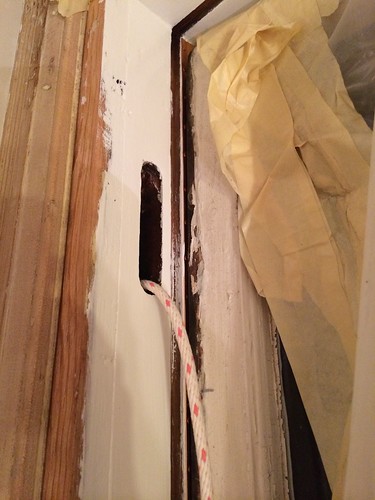
One time the drill bit hits bottom, run the pulley upward the string and put it in place.
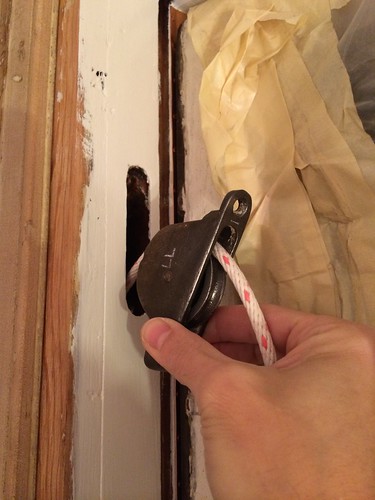
Notation: If y'all're doing this whole process but you're not removing your pulleys, you tin utilize a smaller weight (smaller drill bit?) that will fit through the pulley's opening.
Similar with the upper sash, information technology's time to tie on the weights. In our windows the weights for the upper sash are larger and heavier than the lower. It makes sense, since their job is to continue the sash up rather than to simply counter balance as it's raised. So it's important to take note to ensure you're installing the correct weight for the right sash.

In one case I had the sash weight expert and secure, I started working on the length of the cord I'd need. Like to the upper sash, the key here is to get the length of the rope correct, but using an opposing approach. With the lower sash y'all demand to be sure that the window can exist fully raised without the weight impacting the bottom of the cavity, only it needs to be able to be closed without the knot or weight running into the pulley.
And then I grab the lower sash, make annotation of the knot hole along the side, and hold it in place in the window opening. In this case, like the upper sash, I hold the sash in place well-nigh the acme of the window in information technology'southward fully open position. Once I'one thousand happy with it, I mark the top of the hole on the jamb.

With the jamb marked, I grab the string and pull down (pulling the weight upwardly) until the weight is just slightly higher up the base of operations of the window frame. This will be where the weight rests when the window is fully open up. I find it'southward easier to measure the string length for the lower sash fully open rather than fully airtight.
Finally, make a pencil marking on the rope where you marked the jamb for the knot hole location.
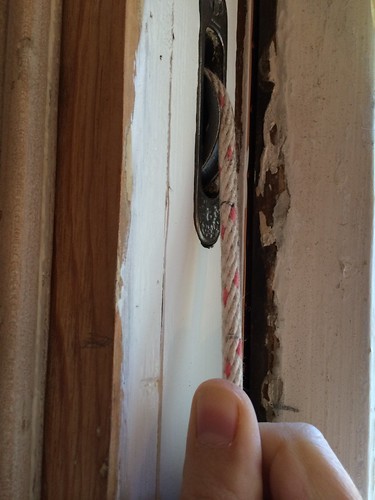
In the same manner as with the upper sash, cut the cord nigh a foot longer than the pencil mark and tie a knot that stops at the line.
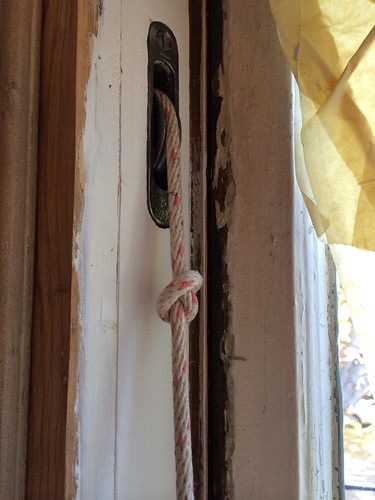
In one case this was done on both sides, I had my ropes in identify and was nearing completion. Letting go of the lower sash ropes should cause the knot to rest against the upper portion of the caster.
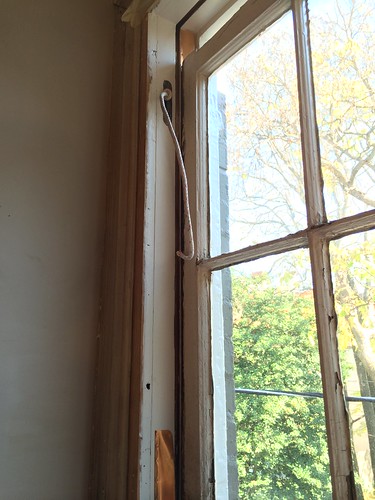
Attaching the ropes to the sash in the same fashion as I did on the upper sash and we've for a fully functional window!

It'due south important to note that I skipped the step of reinstalling the window'southward parting bead and sash stops equally I intend to take the sash out again to strip and reglaze them. I'll tell you ane thing for sure, those parting beads sure do offering a tremendous amount of draft reduction. Our windows are super drafty without them.
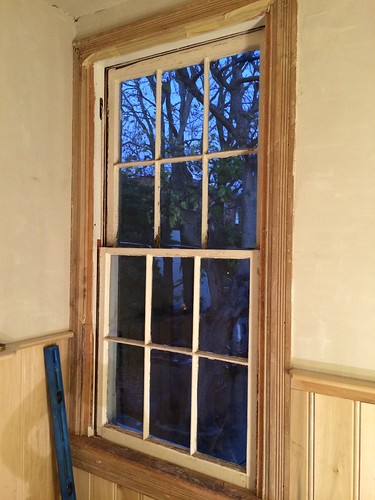
In that location you take it, a full (and frightfully dull) step by step guide on replacing your weight and pulley double hung window's sash cords. I was once rather intimidated by this whole projection, but now that I've done it on several windows, it'south a completely bearable project that I'grand excited to undertake on the remaining original windows of our dwelling.
At present that the sash are restrung we accept a final few major steps left before these windows can be called fully finished. Lets recap from our window restoration checklist.
- Disassembly
- Frame Paint Removal
- Frame/Component Repair
- Weather Stripping
- Restring Sash Cord
- Tempest Window Installation
- Sash Removal and Repair (this is a multi-step ane on its own)
What do you lot think? Is this something you're going to put to use in your home? Does it seem manageable to you, or extremely involved and simply too much work?
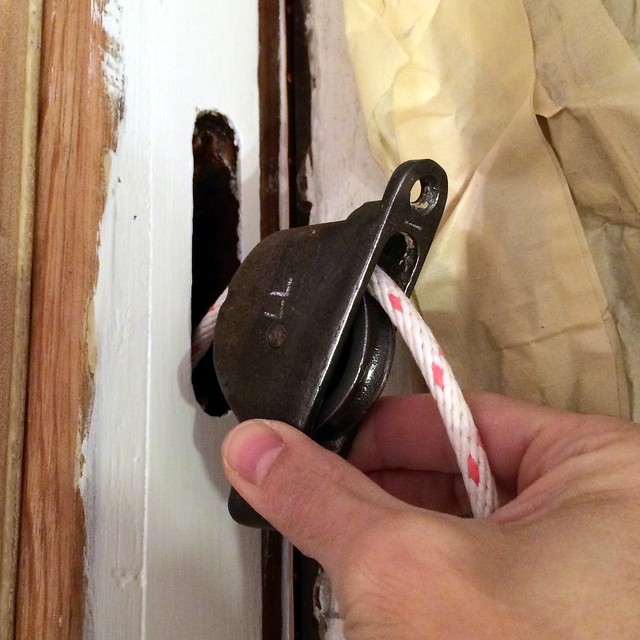
How To Fix Old Windows With Ropes,
Source: https://www.oldtownhome.com/2014/1/30/Window-Restoration-How-To-Re-Rope-Sash-Cord/
Posted by: goyetteoundiciat.blogspot.com


0 Response to "How To Fix Old Windows With Ropes"
Post a Comment